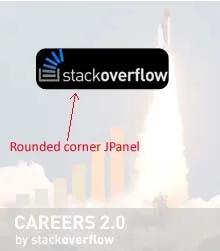我已经研究了这个问题,但无法看到如何在单个系统类调用中完成此操作。
Graphics2D是一个抽象实例,实现为SunGraphics2D。源代码可在例如
docjar上找到,因此我们可能只需“做同样的事情,但不同”的方式复制一些代码。但是,绘制图像的方法取决于一些不可用的“管道”类。虽然您可以使用类加载来处理,但可能会遇到某些本地优化类,无法操纵以实现理论上最佳的方法;您获得的只是将图像绘制为正方形。
但是,我们可以采用一种方法,在该方法中,我们自己的非本机(即:较慢)代码尽可能少地运行,并且不依赖于图像大小,而是依赖于圆角矩形中(相对)较低的面积。此外,不会在内存中复制图像,从而消耗大量内存。但是,如果您有很多内存,那么显然,在创建实例后,缓存的图像更快。
备选方案1:
import java.awt.Composite;
import java.awt.CompositeContext;
import java.awt.Dimension;
import java.awt.Graphics;
import java.awt.Graphics2D;
import java.awt.RenderingHints;
import java.awt.image.BufferedImage;
import java.awt.image.ColorModel;
import java.awt.image.Raster;
import java.awt.image.WritableRaster;
import javax.swing.JLabel;
public class TPanel2 extends JLabel implements Composite, CompositeContext {
private int w = 300;
private int h = 200;
private int cornerRadius = 20;
private int[] roundRect;
private BufferedImage image;
private int[][] first = new int[cornerRadius][];
private int[][] second = new int[cornerRadius][];
private int[][] third = new int[cornerRadius][];
private int[][] forth = new int[cornerRadius][];
public TPanel2() {
setOpaque(false);
setPreferredSize(new Dimension(w, h));
setMaximumSize(new Dimension(w, h));
setMinimumSize(new Dimension(w, h));
roundRect = new int[cornerRadius];
for(int i = 0; i < roundRect.length; i++) {
roundRect[i] = (int)(Math.cos(Math.asin(1 - ((double)i)/20))*20);
}
image = new BufferedImage(w, h, BufferedImage.TYPE_INT_ARGB);
}
@Override
public void paintComponent(Graphics g) {
if(g instanceof Graphics2D) {
Graphics2D g2d = (Graphics2D) g;
g2d.setComposite(this);
g2d.drawImage(image, 0, 0, null);
} else {
super.paintComponent(g);
}
}
@Override
public CompositeContext createContext(ColorModel srcColorModel,
ColorModel dstColorModel, RenderingHints hints) {
return this;
}
@Override
public void dispose() {
}
@Override
public void compose(Raster src, Raster dstIn, WritableRaster dstOut) {
for(int i = 0; i < cornerRadius; i++) {
first[i] = (int[]) dstOut.getDataElements(src.getWidth() - (cornerRadius - roundRect[i]), i, cornerRadius - roundRect[i], 1, first[i]);
second[i] = (int[]) dstOut.getDataElements(0, i, cornerRadius - roundRect[i], 1, second[i]);
third[i] = (int[]) dstOut.getDataElements(0, src.getHeight() - i - 1, cornerRadius - roundRect[i], 1, third[i]);
forth[i] = (int[]) dstOut.getDataElements(src.getWidth() - cornerRadius + roundRect[i], src.getHeight() - i - 1, cornerRadius - roundRect[i], 1, forth[i]);
}
dstOut.setRect(src);
for(int i = 0; i < cornerRadius; i++) {
dstOut.setDataElements(src.getWidth() - cornerRadius + roundRect[i], i, first[i].length, 1, second[i]);
dstOut.setDataElements(0, i, second[i].length, 1, second[i]);
dstOut.setDataElements(0, src.getHeight() - i - 1, third[i].length, 1, third[i]);
dstOut.setDataElements(src.getWidth() - cornerRadius + roundRect[i], src.getHeight() - i - 1, forth[i].length, 1, forth[i]);
}
}
}
替代方案2:
import java.awt.AlphaComposite;
import java.awt.Composite;
import java.awt.CompositeContext;
import java.awt.Dimension;
import java.awt.Graphics;
import java.awt.Graphics2D;
import java.awt.RenderingHints;
import java.awt.image.BufferedImage;
import java.awt.image.ColorModel;
import java.awt.image.Raster;
import java.awt.image.WritableRaster;
import javax.swing.JLabel;
public class TPanel extends JLabel implements Composite, CompositeContext {
private int w = 300;
private int h = 200;
private int cornerRadius = 20;
private int[] roundRect;
private BufferedImage image;
private boolean initialized = false;
private int[][] first = new int[cornerRadius][];
private int[][] second = new int[cornerRadius][];
private int[][] third = new int[cornerRadius][];
private int[][] forth = new int[cornerRadius][];
public TPanel() {
setOpaque(false);
setPreferredSize(new Dimension(w, h));
setMaximumSize(new Dimension(w, h));
setMinimumSize(new Dimension(w, h));
roundRect = new int[cornerRadius];
for(int i = 0; i < roundRect.length; i++) {
roundRect[i] = (int)(Math.cos(Math.asin(1 - ((double)i)/20))*20);
}
image = new BufferedImage(w, h, BufferedImage.TYPE_INT_ARGB);
}
@Override
public void paintComponent(Graphics g) {
if(g instanceof Graphics2D) {
Graphics2D g2d = (Graphics2D) g;
g2d.setComposite(AlphaComposite.Src);
g2d.drawImage(image, cornerRadius, 0, image.getWidth() - cornerRadius - cornerRadius, image.getHeight(), null);
g2d.drawImage(image, 0, cornerRadius, cornerRadius, image.getHeight() - cornerRadius - cornerRadius, null);
g2d.drawImage(image, image.getWidth() - cornerRadius, cornerRadius, image.getWidth(), image.getHeight() - cornerRadius, image.getWidth() - cornerRadius, cornerRadius, image.getWidth(), image.getHeight() - cornerRadius, null);
g2d.setComposite(this);
g2d.drawImage(image, 0, 0, null);
} else {
super.paintComponent(g);
}
}
@Override
public CompositeContext createContext(ColorModel srcColorModel,
ColorModel dstColorModel, RenderingHints hints) {
return this;
}
@Override
public void dispose() {
}
@Override
public void compose(Raster src, Raster dstIn, WritableRaster dstOut) {
if(!initialized) {
for(int i = 0; i < cornerRadius; i++) {
first[i] = (int[]) src.getDataElements(src.getWidth() - cornerRadius, i, roundRect[i], 1, first[i]);
second[i] = (int[]) src.getDataElements(cornerRadius - roundRect[i], i, roundRect[i], 1, second[i]);
third[i] = (int[]) src.getDataElements(cornerRadius - roundRect[i], src.getHeight() - i - 1, roundRect[i], 1, third[i]);
forth[i] = (int[]) src.getDataElements(src.getWidth() - cornerRadius, src.getHeight() - i - 1, roundRect[i], 1, forth[i]);
}
initialized = true;
}
for(int i = 0; i < cornerRadius; i++) {
dstOut.setDataElements(src.getWidth() - cornerRadius, i, first[i].length, 1, second[i]);
dstOut.setDataElements(cornerRadius - roundRect[i], i, second[i].length, 1, second[i]);
dstOut.setDataElements(cornerRadius - roundRect[i], src.getHeight() - i - 1, third[i].length, 1, third[i]);
dstOut.setDataElements(src.getWidth() - cornerRadius, src.getHeight() - i - 1, forth[i].length, 1, forth[i]);
}
}
}
希望这可以帮到你,虽然这只是一个次优解决方案,但这就是生活(当一些图形大师来证明我错了时(??)...);-)
